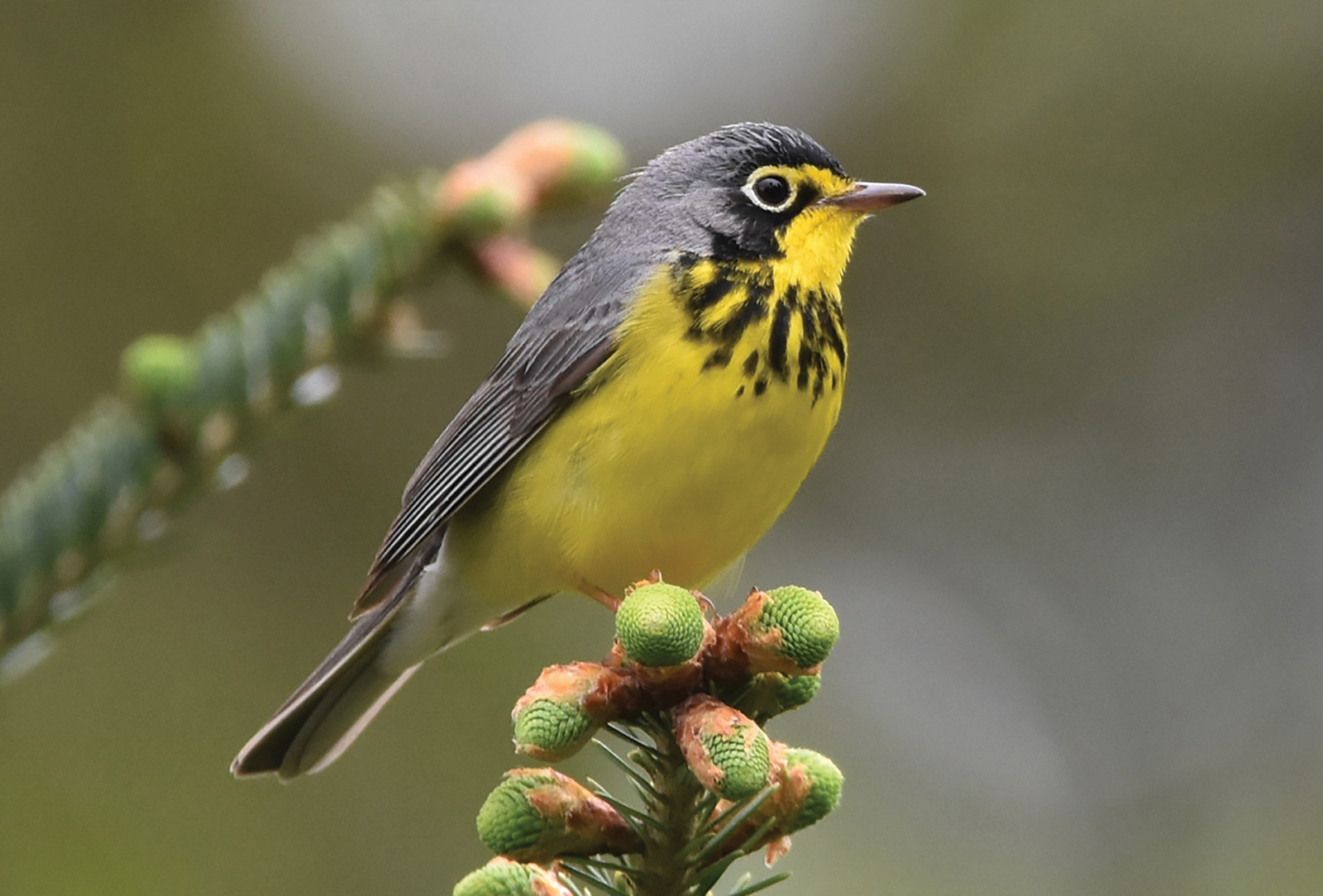In British Columbia, during the spring and summer months when warblers arrive, it is quite common to spot yellow birds. However, in the winter season, the number of yellow bird species decreases significantly.
To assist you in identifying the yellow birds you come across in British Columbia, this comprehensive guide offers pictures, identification information, song recordings, and details about their migration patterns.
The majority of yellow birds in British Columbia belong to the warbler, oriole, or tanager families. Sometimes, female birds of these species exhibit distinct appearances compared to their male counterparts.
By utilizing the information provided in this guide, identifying yellow birds will become a much simpler task. The list of yellow birds included here is arranged according to their frequency of sightings in British Columbia during the spring and summer months, based on ebird checklists for May and June.
Yellow birds found in British Columbia throughout the year include the Western Meadowlark and Evening Grosbeak. During the summer season, you can also spot the Yellow-rumped Warbler, American Goldfinch, Cedar Waxwing, Orange-crowned Warbler, Common Yellowthroat, Yellow Warbler, Western Tanager, Wilson’s Warbler, Yellow-headed Blackbird, American Redstart, Nashville Warbler, Western Kingbird, Magnolia Warbler, Black-throated Green Warbler, Baltimore Oriole, Canada Warbler, and Cape May Warbler. Additionally, during migration, Palm Warblers and Tropical Kingbirds can be observed in British Columbia.
Continue reading to gain valuable insights into identifying the yellow birds you have encountered.
Here are 21 Yellow Birds in British Columbia:
1. Yellow-rumped Warbler
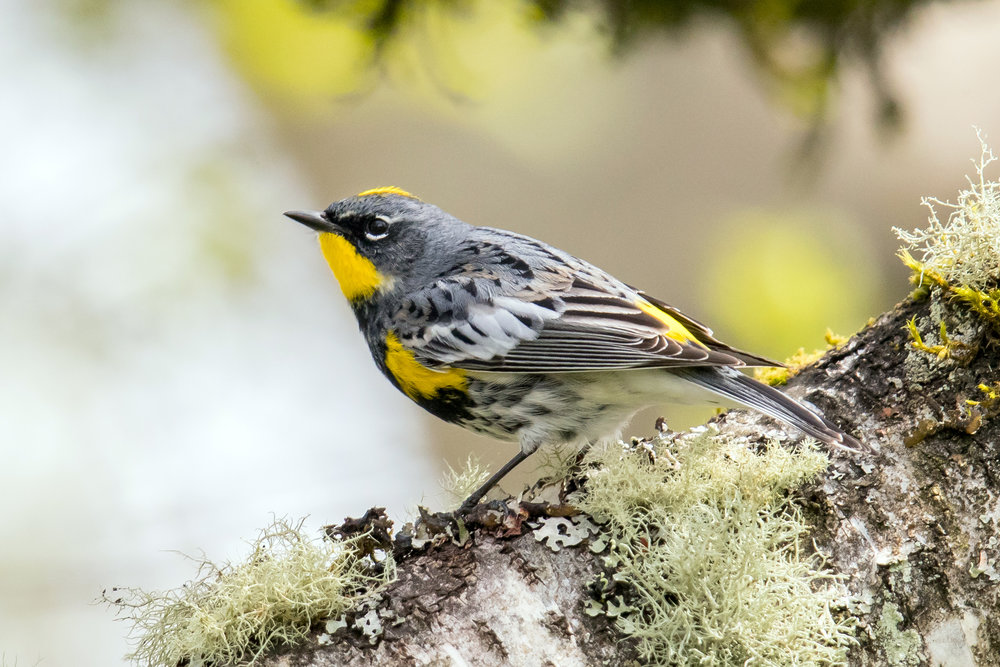
The Yellow-rumped Warbler can be seen in British Columbia during the breeding season. However, their numbers increase significantly during migration, which occurs from April to May and September to October. These birds are present in approximately 22% of checklists during the summer and up to 50% during migration.
Yellow-rumped Warblers have a gray body with yellow flashes on their face, sides, and rump, along with white wings. Female individuals may exhibit a slight brown coloration, while winter birds appear as paler brown with bright yellow rumps and sides, transitioning back to yellow and gray in the spring.
Scientific name: Setophaga coronata
Size: 4.7-5.5 in (12-14 cm)
Weight: 0.4-0.5 oz (12-13 g)
Wingspan: 7.5-9.1 in (19-23 cm)
These warblers primarily breed in Canada, as well as certain regions of the Rockies and the Appalachian mountains. During migration, they can be observed in the Midwest before overwintering in southern and southwestern US states, along the Pacific Coast, and extending into Mexico and Central America.
Yellow-rumped Warblers prefer coniferous forests, especially during the breeding season. In winter, they tend to inhabit open areas with fruiting shrubs. Their diet consists primarily of insects during the summer and migration periods, while they rely more on fruit consumption, including bayberry and wax myrtle, during the winter.
2. American Goldfinch
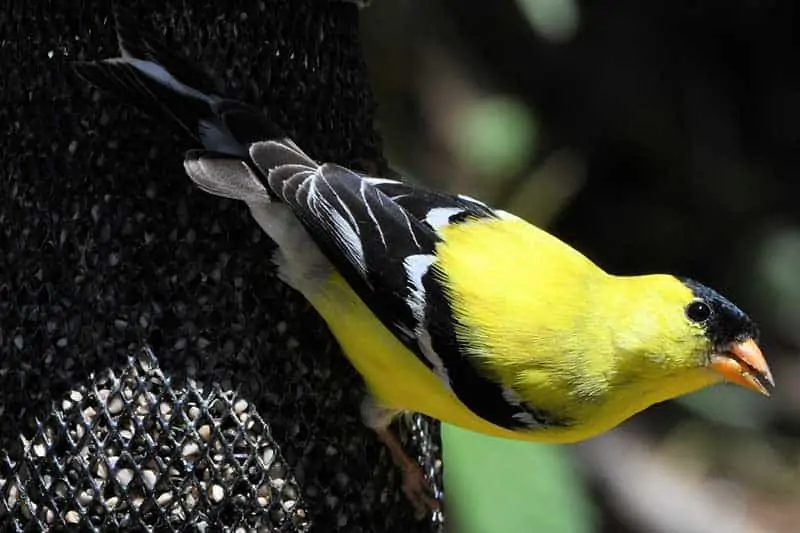
American Goldfinches are predominantly found in the southern regions of British Columbia during the breeding season, although some individuals remain throughout the year. They are present in approximately 21% of summer checklists and 7% of winter checklists.
These birds are popular due to the vibrant yellow and black coloring displayed by males during the spring. Females and winter males exhibit a duller brown coloration.
Scientific name: Spinus tristis
Size: 4.3-5.1 in (11-13 cm)
Weight: 0.4-0.7 oz (11-20 g)
Wingspan: 7.5-8.7 in (19-22 cm)
American Goldfinches can be found across most of North America and are typically resident throughout the year. However, those that breed in Canada and the Midwest migrate to southern US states during winter.
These goldfinches are commonly found in weedy fields, overgrown areas, suburbs, parks, and backyards. Their diet mainly consists of sunflower and thistle seeds, as well as aster plants. They readily visit most types of bird feeders and have a preference for sunflower and nyjer seeds.
3. Cedar Waxwing

Cedar Waxwings are frequently observed in British Columbia during the breeding season, with a few individuals remaining throughout the year. They are present in approximately 18% of summer checklists and 1% of winter checklists.
These elegant and sociable birds have pale brown heads, chests, and crests, which transition to gray on their backs and wings. Their bellies feature a pale yellow coloration, and their wings exhibit bright yellow tips. They have narrow black masks over their eyes and bright red accents on their wingtips.
Scientific name: Bombycilla cedrorum
Size: 5.5-6.7 in (14-17 cm)
Weight: 1.1 oz (32 g)
Wingspan: 8.7-11.8 in (22-30 cm)
Cedar Waxwings breed in Canada before migrating to southern US states, Mexico, and Central America for winter. They are also resident throughout the year in northern US states.
These birds can be found in berry bushes, woodlands, grasslands, towns, and along streams. While their primary diet consists of fruit, they also feed on insects during the summer season.
4. Orange-crowned Warbler
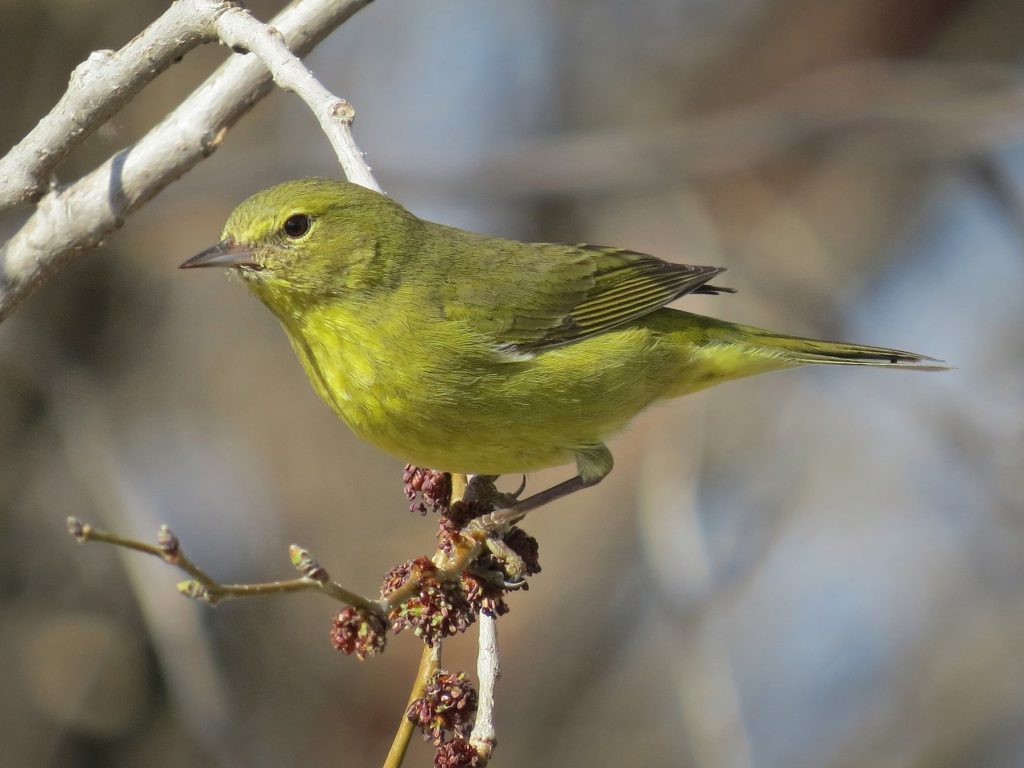
Orange-crowned Warblers spend the breeding season in British Columbia and are mainly observed from April to December. They appear in approximately 16% of summer checklists.
Compared to other warblers, Orange-crowned Warblers are not as vibrantly colored. They exhibit yellow-olive coloring, which appears more yellow along the Pacific Coast. Their orange crown is rarely visible.
Scientific name: Leiothlypis celata
Size: 4.3-5.5 in (11-14 cm)
Weight: 0.3-0.4 oz (7-11 g)
Wingspan: 7.5 in (19 cm)
These warblers breed in Canada and western US states before migrating to the Pacific, East and Gulf Coasts, and Mexico. They can also be observed during migration in most US states, except for the northeastern region.
Orange-crowned Warblers can be found in shrubs, low vegetation, and open woodlands. They primarily feed on spiders and insects such as caterpillars and flies. Additionally, they consume fruit, berries, and seeds, and they frequently visit backyard feeders.
5. Common Yellowthroat

Common Yellowthroats spend the breeding season in British Columbia and are primarily observed from April to October. They are present in approximately 16% of summer checklists.
These small songbirds have brownish backs and bright yellow underparts, with long tails. Male Common Yellowthroats feature black masks across their faces. The intensity of their yellow coloration can vary geographically, and their underparts may appear more olive in certain areas.
Scientific name: Geothlypis trichas
Size: 4.3-5.1 in (11-13 cm)
Weight: 0.3-0.3 oz (9-10 g)
Wingspan: 5.9-7.5 in (15-19 cm)
Common Yellowthroats breed across most of North America, excluding Alaska and northern Canada. Some individuals remain along the Gulf Coast and Pacific Southwest throughout the year, while others migrate south for winter.
These birds are commonly found in marshy or wetland areas, as well as brushy fields with thick, tangled vegetation.
6. Yellow Warbler

Yellow Warblers are frequently spotted in British Columbia during the breeding season, typically arriving in April and beginning their migration in October. They are present in approximately 18% of summer checklists.
These small, bright yellow birds exhibit a yellow-green back, with males showcasing chestnut streaks on their breasts. Females and juveniles appear less vibrant compared to males.
Scientific name: Setophaga petechia
Size: 4.7-5.1 in (12-13 cm)
Weight: 0.3-0.4 oz (9-11 g)
Wingspan: 6.3-7.9 in (16-20 cm)
Yellow Warblers migrate long distances to breed in Canada and the US, excluding southeastern states, before returning to Central and South America for winter. During migration, they can also be observed in southeastern US states.
These warblers can be found along streams, wetlands, thickets, and field edges, where they forage for insects, including caterpillars, midges, beetles, bugs, and wasps.
7. Western Tanager

Western Tanagers are observed in British Columbia during the breeding season, typically from April to September, with a few individuals remaining until February. They appear in approximately 13% of summer checklists.
Male Western Tanagers exhibit a flaming orange-red head, yellow body, and black wings. Females have red faces and yellow-green bodies.
Scientific name: Piranga ludoviciana
Size: 6.3-7.5 in (16-19 cm)
Weight: 0.8-1.3 oz (24-36 g)
Wingspan: 16.1 in (41 cm)
These tanagers breed in western US states and western Canada. During migration, they can be observed in the eastern and southern parts of their range. They spend their winter months in Mexico and Central America.
Western Tanagers prefer open conifer forests, where they often remain hidden within the canopy despite their vibrant coloring. In recent decades, their population numbers have actually increased.
8. Wilson’s Warbler

Wilson’s Warblers are observed in British Columbia during the summer season and are primarily spotted from May to mid-October. They appear in approximately 12% of checklists during this period.
These tiny, round yellow warblers have a large black cap in males and a smaller black cap in females.
Scientific name: Cardellina pusilla
Size: 3.9-4.7 in (10-12 cm)
Weight: 0.2-0.3 oz (5-10 g)
Wingspan: 5.5-6.7 in (14-17 cm)
Wilson’s Warblers breed in Canada, Alaska, and northwestern US states. They can be observed across all US states during migration, while they spend their winter months in Mexico and Central America.
These warblers are commonly found along streams, in thickets, and near forest edges, where they forage for insects, larvae, and spiders.
9. Western Meadowlark

Western Meadowlarks can be observed throughout the year in British Columbia, with a higher concentration in the southern regions from April to June. They appear in approximately 5% of summer checklists and 1% of winter checklists.
With bright yellow bellies and melodic songs, Western Meadowlarks bring joy to any observer.
Scientific name: Sturnella neglecta
Size: 6.3-10.2 in (16-26 cm)
Weight: 3.1-4.1 oz (89-115 g)
Wingspan: 16.1 in (41 cm)
These meadowlarks breed in northern US states and Canada, migrating to more southern states during winter. However, individuals in the western and midwestern regions remain resident throughout the year.
Western Meadowlarks are typically found on the ground in grasslands, meadows, and fields. They forage alone or in small flocks and are not commonly found in wooded areas or dense shrubbery.
10. Evening Grosbeak

Evening Grosbeaks are considered a vulnerable species in British Columbia, but they can be observed throughout the year, primarily in the southern regions of the province. They appear in approximately 3% of summer checklists and 1% of winter checklists.
These chunky birds have large bills and feature a striking yellow and black pattern. Adult males have a bright yellow stripe over their eyes, giving them a fierce appearance. Their heads are black, with gray necks, and their chests and bellies are yellow. They also possess a white patch on their wings.
Scientific name: Coccothraustes vespertinus
Size: 16 to 22 cm (6.3 to 8.7 in)
Weight: 38.7 to 86.1 g (1.37 to 3.04 oz)
Wingspan: 30 to 36 cm (12 to 14 in)
Evening Grosbeaks remain throughout the year in southern Canada and down the west coast to northern California. However, they migrate south to various US states when cone crops are scarce.
These birds are commonly found in forests and mountainous regions. They are often attracted to backyard bird feeders, particularly during winter, as they consume seeds, berries, and small fruit.
11. Yellow-headed Blackbird
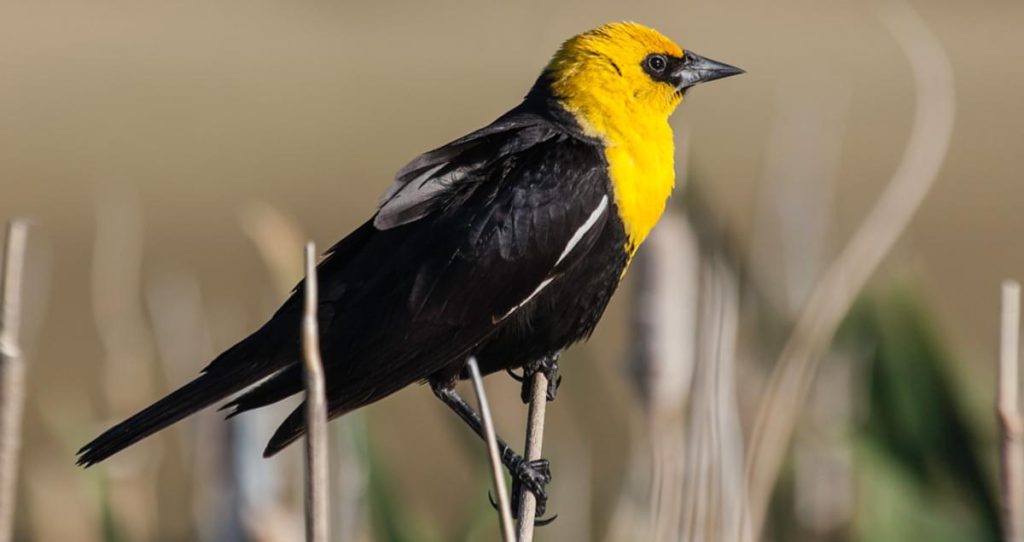
Yellow-headed Blackbirds can be spotted in British Columbia during the summer season. They are frequently observed from May to September and appear in approximately 8% of summer checklists.
These blackbirds are known for their striking appearance, featuring a black body with a vibrant yellow head and breast. Females have a more subdued coloration, with a brownish hue.
Scientific name: Xanthocephalus xanthocephalus
Size: 8.3-10.6 in (21-27 cm)
Weight: 2.5-4.1 oz (71-117 g)
Wingspan: 15.8-16.5 in (40-42 cm)
Yellow-headed Blackbirds breed across western North America, including British Columbia, before migrating to southern US states and Mexico for winter.
They can be found in marshes, wetlands, and areas with tall grasses, where they forage for insects and seeds.
12. American Redstart

American Redstarts can be observed in British Columbia during the summer season, primarily from May to September. They appear in approximately 7% of summer checklists.
These warblers are known for their striking black and orange plumage. Males display a predominantly black coloration with vibrant orange patches on their wings, tail, and sides. Females have more subdued colors, featuring gray and yellow tones.
Scientific name: Setophaga ruticilla
Size: 4.3-5.1 in (11-13 cm)
Weight: 0.2-0.4 oz (5-11 g)
Wingspan: 7.5-8.7 in (19-22 cm)
American Redstarts breed across eastern North America, including parts of Canada and the northeastern United States. During migration, they can be observed in various regions of the US.
These warblers inhabit forests, woodlands, and shrubby areas, where they actively forage for insects.
13. Nashville Warbler
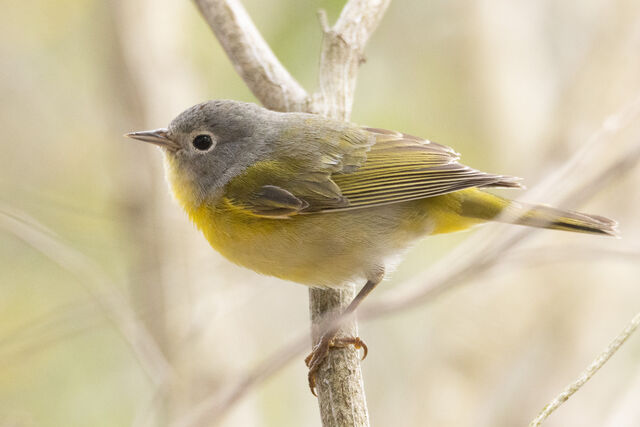
Nashville Warblers are frequently spotted in British Columbia during the summer season. They are observed from May to September and appear in approximately 7% of summer checklists.
These warblers feature a combination of bright yellow and gray plumage. They have a yellow head and underparts, with a gray back and wings. Additionally, they exhibit a distinct white eye ring.
Scientific name: Leiothlypis ruficapilla
Size: 4.3-4.7 in (11-12 cm)
Weight: 0.2-0.3 oz (5-8 g)
Wingspan: 6.7-7.1 in (17-18 cm)
Nashville Warblers breed across North America, from the boreal forests of Canada to the northeastern and north-central United States. During migration, they can be observed in various regions.
These warblers inhabit forests, thickets, and shrubby areas, where they actively forage for insects and spiders.
14. Western Kingbird
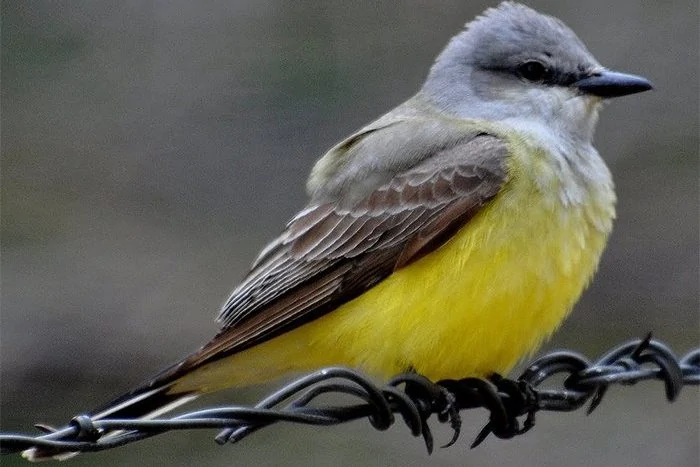
Western Kingbirds are frequently observed in British Columbia during the summer season, primarily from May to September. They appear in approximately 7% of summer checklists.
These kingbirds have a distinct appearance, featuring a grayish-olive back, a yellow belly, and a black tail with white outer feathers. They also possess a small, concealed red patch on their crown.
Scientific name: Tyrannus verticalis
Size: 7.5-8.3 in (19-21 cm)
Weight: 1.1-1.4 oz (31-39 g)
Wingspan: 14.6-15.4 in (37-39 cm)
Western Kingbirds breed across western North America, including parts of Canada, before migrating to Central and South America for winter.
These kingbirds inhabit open areas, including grasslands, meadows, and agricultural fields, where they feed on insects, particularly aerial insects caught during their acrobatic flights.
15. Magnolia Warbler
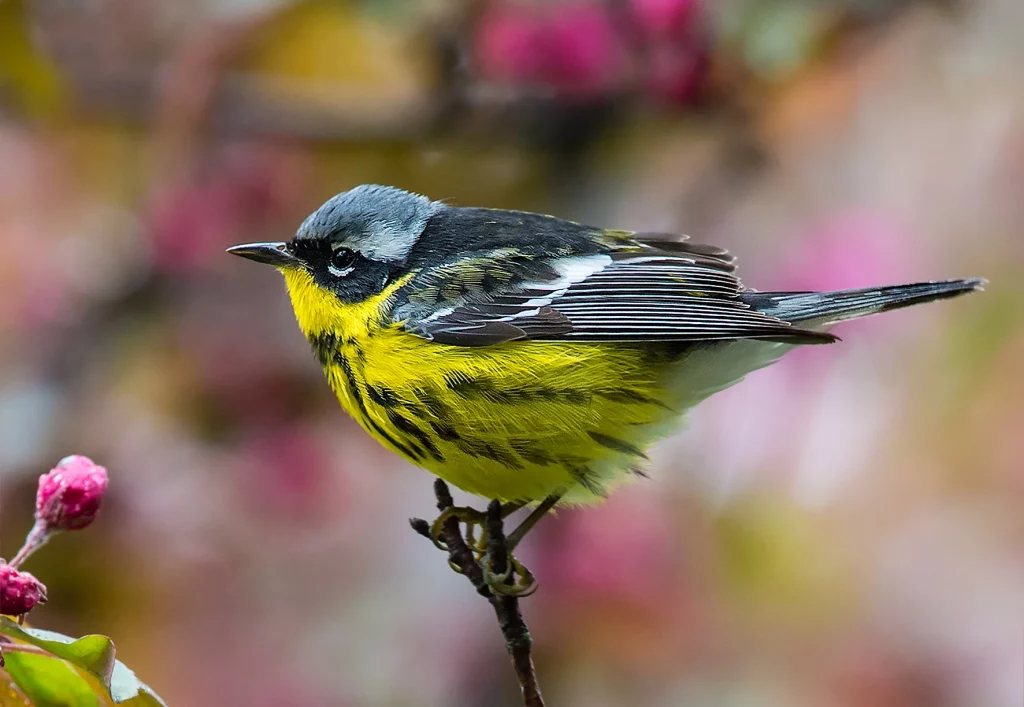
Magnolia Warblers can be observed in British Columbia during the summer season, typically from May to September. They appear in approximately 6% of summer checklists.
These warblers showcase a vibrant yellow underbody with a black necklace-like band across their chest. Their back and wings exhibit a combination of gray, black, and white patterns.
Scientific name: Setophaga magnolia
Size: 4.3-5.1 in (11-13 cm)
Weight: 0.3-0.4 oz (9-11 g)
Wingspan: 7.5-8.7 in (19-22 cm)
Magnolia Warblers breed across the boreal forests of Canada and parts of the northeastern United States. During migration, they can be observed in various regions.
These warblers primarily inhabit forests and woodlands, where they actively forage for insects, spiders, and caterpillars.
16. Black-throated Green Warbler
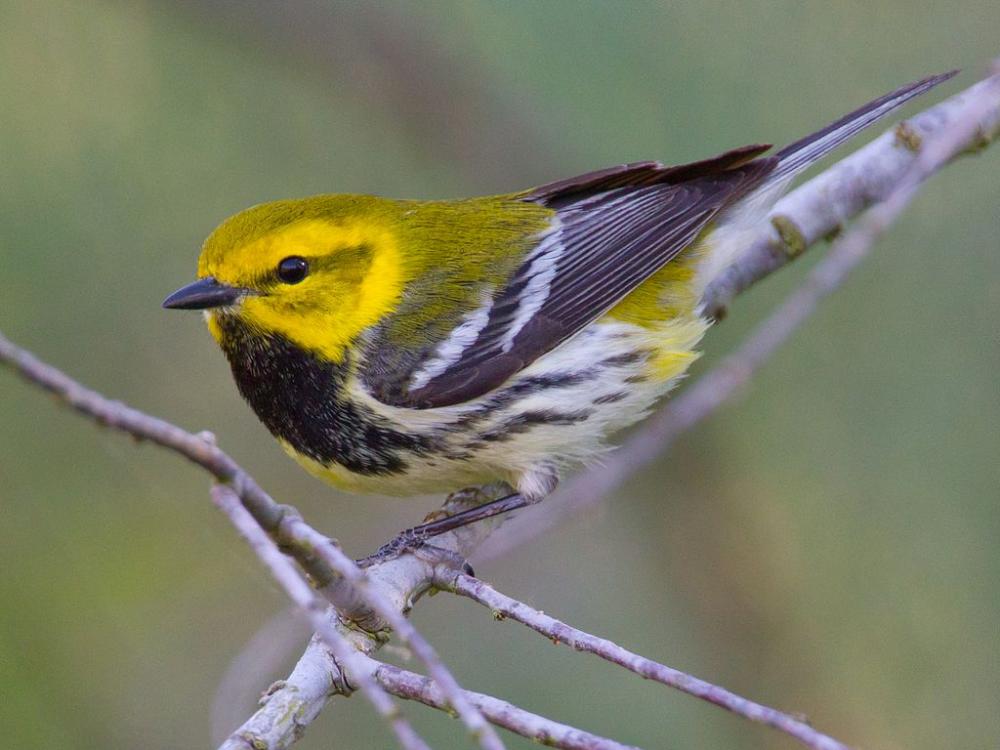
Black-throated Green Warblers can be spotted in British Columbia during the summer season, typically from May to September. They appear in approximately 6% of summer checklists.
These warblers exhibit a combination of yellow and olive-green plumage. Males showcase a black throat and face, while females have a lighter coloration and lack the black throat patch.
Scientific name: Setophaga virens
Size: 4.3-5.1 in (11-13 cm)
Weight: 0.3-0.4 oz (9-11 g)
Wingspan: 7.5-8.7 in (19-22 cm)
Black-throated Green Warblers breed across the boreal forests of Canada and the northeastern United States. During migration, they can be observed in various regions.
These warblers inhabit coniferous and mixed forests, where they actively forage for insects and spiders.
17. Baltimore Oriole

Baltimore Orioles are frequently observed in British Columbia during the summer season, primarily from May to September. They appear in approximately 6% of summer checklists.
These orioles are known for their vibrant orange plumage, with black accents on their wings and head. Females have a more subdued coloration, featuring yellowish-orange tones.
Scientific name: Icterus galbula
Size: 7.5 in (19 cm)
Weight: 1.1-1.5 oz (31-42 g)
Wingspan: 9-12 in (23-30 cm)
Baltimore Orioles breed across eastern North America, including parts of Canada and the eastern United States. During migration, they can be observed in various regions.
These orioles inhabit open woodlands, forest edges, and suburban areas, where they actively feed on insects, nectar, and fruits.
18. Canada Warbler

Canada Warblers are observed in British Columbia during the summer season, typically from May to September. They appear in approximately 5% of summer checklists.
These warblers feature a grayish-blue back, yellow underparts, and a distinct necklace-like band across their chest. They also possess a white eye ring.
Scientific name: Cardellina canadensis
Size: 4.3-5.1 in (11-13 cm)
Weight: 0.3-0.4 oz (8-12 g)
Wingspan: 7.5-8.3 in (19-21 cm)
Canada Warblers breed across the boreal forests of Canada and parts of the northeastern United States. During migration, they can be observed in various regions.
These warblers primarily inhabit moist, dense forests, where they actively forage for insects, spiders, and small fruits.
19. Cape May Warbler
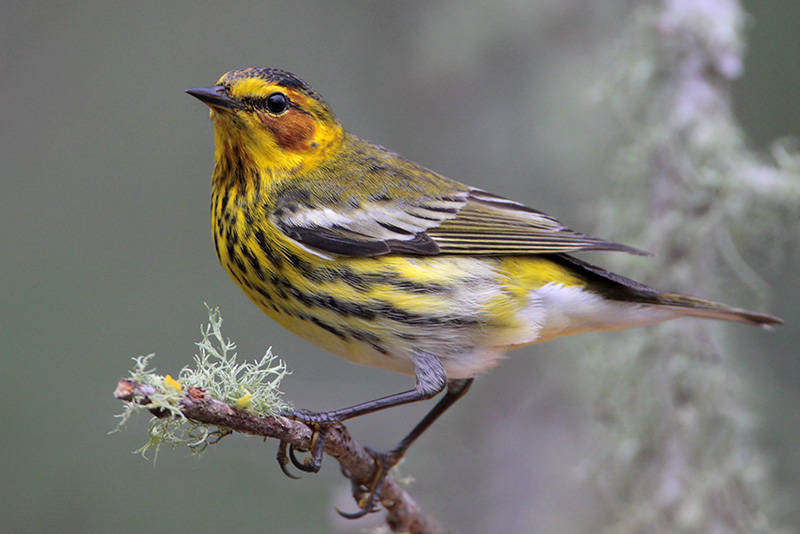
Cape May Warblers can be observed in British Columbia during the summer season, typically from May to September. They appear in approximately 4% of summer checklists.
These warblers showcase a combination of yellow, olive-green, and chestnut plumage. They have a distinctive chestnut cheek patch and a yellow rump.
Scientific name: Setophaga tigrina
Size: 4.3-5.1 in (11-13 cm)
Weight: 0.3-0.4 oz (8-11 g)
Wingspan: 7.5-8.7 in (19-22 cm)
Cape May Warblers breed across the boreal forests of Canada and parts of the northeastern United States. During migration, they can be observed in various regions.
These warblers primarily inhabit coniferous forests, where they actively forage for insects, including spruce budworms.
20. Palm Warbler

Palm Warblers are frequently spotted in British Columbia during migration. They can be observed from April to May and from September to October.
These warblers exhibit a combination of brown and yellow plumage. They have a yellow underbody with brown streaks on their sides and breast.
Scientific name: Setophaga palmarum
Size: 4.7-5.1 in (12-13 cm)
Weight: 0.3-0.4 oz (9-11 g)
Wingspan: 7.5-8.3 in (19-21 cm)
Palm Warblers breed in the boreal forests of Canada and Alaska before migrating south to spend their winter months in the southeastern United States, the Caribbean, and Central America.
During migration, they can be observed in various habitats, including woodlands, shrubby areas, and open fields.
21. Tropical Kingbird

Tropical Kingbirds can be observed in British Columbia during migration. They are spotted from April to May and from September to October.
These kingbirds have a bold appearance, featuring a gray head, back, and wings, with a yellow belly and throat.
Scientific name: Tyrannus melancholicus
Size: 7.9-9.1 in (20-23 cm)
Weight: 1.0-1.4 oz (28-40 g)
Wingspan: 15.4-16.5 in (39-42 cm)
Tropical Kingbirds breed in the southern United States and southward into Central and South America. During migration, they can be observed in various regions, including British Columbia.
These kingbirds inhabit open areas, including woodlands, parks, and agricultural fields, where they actively hunt for insects, particularly aerial insects caught during their impressive flights.
Please note that the information provided is based on the known behavior and distribution of these bird species up until September 2021.
